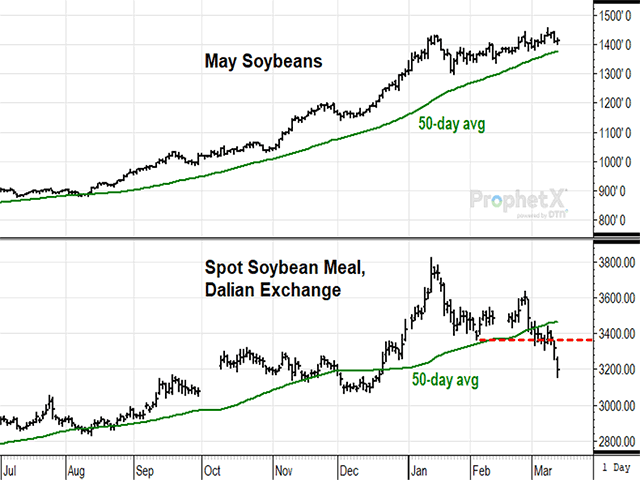Todd's Take
Soybeans Encounter First Bearish Threat
A common theme over the past year has been that we do not know much about what is happening within the borders of China, but at least we can observe prices on the Dalian Exchange and get a hint of what is going on inside. For many months, China's prices of corn, soybeans and soy products have signaled strong domestic demand, rising to new heights, even as China gathered greater-than-expected imports from abroad. Here in the U.S., the strength of the recent bull markets in corn and soybeans have surprised us all.
This past week, two of those rising prices in China broke support for the first time in several months. On Wednesday, March 10, spot corn on China's Dalian Exchange closed below its 50-day average for only the second time since May 2020. On Thursday, corn posted its lowest close in 2021.
The bearish break in China's spot contract of soybean meal was even more pronounced. Thursday's close of 3,199 yuan per metric ton was down 16% from the high made on Jan. 13 and was also the lowest close in 2021.
For several weeks, the market had been hearing reports that China was once again confronting new cases of African swine fever (ASF), but it took this week's bearish turns in China's corn and soybean meal prices to get the market to pay attention.
Here in the U.S., the market paid attention for at least one day, as May corn fell 11 3/4 cents on Wednesday and May soybean meal dropped $11.80 in two days, reaching a close of $404.80 on Thursday. For May corn, no technical damage has been done yet, but in the case of May soybean meal, Thursday's close was a new two-month low and probably put pressure on noncommercials to liquidate at least some of their net-long positions.
Despite the new weakness in soybean meal prices, May soybeans remain firm in their uptrend, and the question of the moment is, will these new concerns about ASF 2.0 mark the end of the bull market in soybeans?
P[L1] D[0x0] M[300x250] OOP[F] ADUNIT[] T[]
Fundamentally, my initial response is no, I don't think the soybean bull market has seen its top yet. The quick answer is that, even with these new concerns, U.S. crush demand has stayed active and export sales continue to edge higher each week. Granted, export business is gradually moving south as Brazil's harvest makes slow progress, but U.S. soybean export commitments already total 2.22 billion bushels (bb), just 30 million bushels (mb) shy of USDA export estimate for all of 2020-21.
I would also like to remind everyone that the impact on feed demand was likely far worse under the first emergence of ASF after late 2018. Going by USDA estimates in the Livestock and Poultry: World Markets and Trade, China's pork production fell 21% in 2019 and fell another 11% in 2020
(https://downloads.usda.library.cornell.edu/…).
In 2021, USDA's attaches to Beijing expect China's pork production to increase 14%, fueled by aggressive expansion, which the attaches also acknowledge will be undermined by animal diseases (https://apps.fas.usda.gov/…).
What was the impact of the first round of ASF on China's soybean demand? According to USDA, China's soybean demand increased 7% in 2019-20 and world soybean demand hit a new record high of 356.82 million metric tons (mmt) or 13.11 bb.
Even if China failed to register any pork production increase in 2021, it is difficult to see how it would have significant impact on the extremely tight supply situation soybeans now find themselves in.
The risk, of course, is the possibility ASF 2.0 is far more destructive than anyone yet realizes, but the chances of that seem slim, and I have not heard anyone expressing that view yet.
Currently, there are many moving parts for soybean prices these days, including the status of Brazil's harvest, Argentina's new 44.0 mmt crop estimate from the Buenos Aires Grain Exchange Thursday and the prospects for U.S. weather when we get closer to planting time.
Technically speaking, May soybeans have been trending consistently higher since August 2020, and prices are holding above their 30-day average at $13.92 and above their 50-day average at $13.80.
I admit, this week's sharp correction in soybean meal is a possible threat for triggering a limited correction in the price of soybeans. However, until May soybeans show a significant break in upward momentum, it is difficult to be too concerned.
Todd Hultman can be reached at Todd.Hultman@dtn.com
Follow him on Twitter @ToddHultman1
(c) Copyright 2021 DTN, LLC. All rights reserved.




